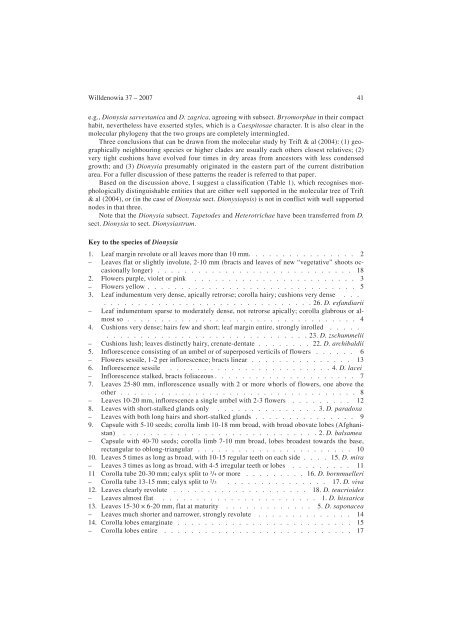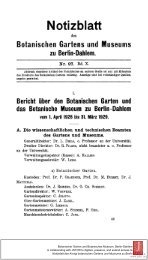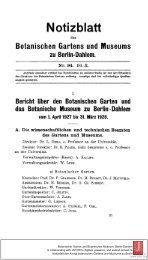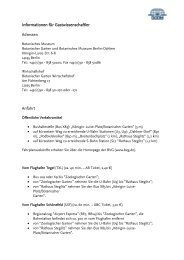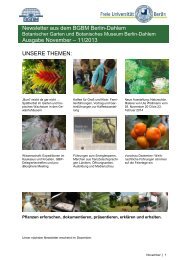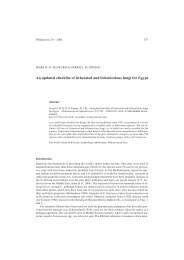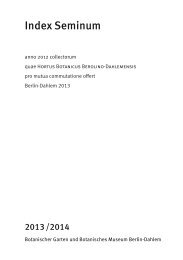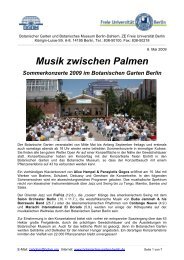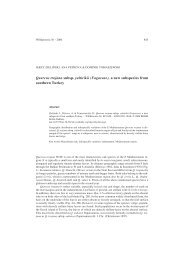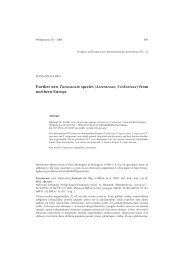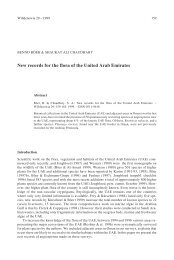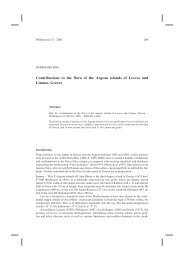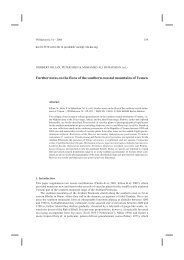The genus Dionysia (Primulaceae), a synopsis and five new species
The genus Dionysia (Primulaceae), a synopsis and five new species
The genus Dionysia (Primulaceae), a synopsis and five new species
You also want an ePaper? Increase the reach of your titles
YUMPU automatically turns print PDFs into web optimized ePapers that Google loves.
Willdenowia 37 – 2007 41<br />
e.g., <strong>Dionysia</strong> sarvestanica <strong>and</strong> D. zagrica, agreeing with subsect. Bryomorphae in their compact<br />
habit, nevertheless have exserted styles, which is a Caespitosae character. It is also clear in the<br />
molecular phylogeny that the two groups are completely intermingled.<br />
Three conclusions that can be drawn from the molecular study by Trift & al (2004): (1) geographically<br />
neighbouring <strong>species</strong> or higher clades are usually each others closest relatives; (2)<br />
very tight cushions have evolved four times in dry areas from ancestors with less condensed<br />
growth; <strong>and</strong> (3) <strong>Dionysia</strong> presumably originated in the eastern part of the current distribution<br />
area. For a fuller discussion of these patterns the reader is referred to that paper.<br />
Based on the discussion above, I suggest a classification (Table 1), which recognises morphologically<br />
distinguishable entities that are either well supported in the molecular tree of Trift<br />
& al (2004), or (in the case of <strong>Dionysia</strong> sect. Dionysiopsis) is not in conflict with well supported<br />
nodes in that three.<br />
Note that the <strong>Dionysia</strong> subsect. Tapetodes <strong>and</strong> Heterotrichae have been transferred from D.<br />
sect. <strong>Dionysia</strong> to sect. <strong>Dionysia</strong>strum.<br />
Key to the <strong>species</strong> of <strong>Dionysia</strong><br />
1. Leaf margin revolute or all leaves more than 10 mm. . . . . . . . . . . . . . . . 2<br />
– Leaves flat or slightly involute, 2-10 mm (bracts <strong>and</strong> leaves of <strong>new</strong> “vegetative” shoots occasionally<br />
longer) . . . . . . . . . . . . . . . . . . . . . . . . . . . . . 18<br />
2. Flowers purple, violet or pink . . . . . . . . . . . . . . . . . . . . . . . . 3<br />
– Flowers yellow . . . . . . . . . . . . . . . . . . . . . . . . . . . . . . . 5<br />
3. Leaf indumentum very dense, apically retrorse; corolla hairy; cushions very dense . . .<br />
. . . . . . . . . . . . . . . . . . . . . . . . . . . . . . . 26. D. esf<strong>and</strong>iarii<br />
– Leaf indumentum sparse to moderately dense, not retrorse apically; corolla glabrous or almost<br />
so . . . . . . . . . . . . . . . . . . . . . . . . . . . . . . . . . . 4<br />
4. Cushions very dense; hairs few <strong>and</strong> short; leaf margin entire, strongly inrolled . . . . .<br />
. . . . . . . . . . . . . . . . . . . . . . . . . . . . . . 23. D. zschummelii<br />
– Cushions lush; leaves distinctly hairy, crenate-dentate . . . . . . . . 22. D. archibaldii<br />
5. Inflorescence consisting of an umbel or of superposed verticils of flowers . . . . . . 6<br />
– Flowers sessile, 1-2 per inflorescence; bracts linear . . . . . . . . . . . . . . . 13<br />
6. Inflorescence sessile . . . . . . . . . . . . . . . . . . . . . . . . 4. D. lacei<br />
– Inflorescence stalked, bracts foliaceous. . . . . . . . . . . . . . . . . . . . . 7<br />
7. Leaves 25-80 mm, inflorescence usually with 2 or more whorls of flowers, one above the<br />
other . . . . . . . . . . . . . . . . . . . . . . . . . . . . . . . . . . . 8<br />
– Leaves 10-20 mm, inflorescence a single umbel with 2-3 flowers . . . . . . . . . 12<br />
8. Leaves with short-stalked gl<strong>and</strong>s only . . . . . . . . . . . . . . . 3. D. paradoxa<br />
– Leaves with both long hairs <strong>and</strong> short-stalked gl<strong>and</strong>s . . . . . . . . . . . . . . . 9<br />
9. Capsule with 5-10 seeds; corolla limb 10-18 mm broad, with broad obovate lobes (Afghanistan)<br />
. . . . . . . . . . . . . . . . . . . . . . . . . . . . . 2. D. balsamea<br />
– Capsule with 40-70 seeds; corolla limb 7-10 mm broad, lobes broadest towards the base,<br />
rectangular to oblong-triangular . . . . . . . . . . . . . . . . . . . . . . . 10<br />
10. Leaves 5 times as long as broad, with 10-15 regular teeth on each side . . . . 15. D. mira<br />
– Leaves 3 times as long as broad, with 4-5 irregular teeth or lobes . . . . . . . . . 11<br />
11 Corolla tube 20-30 mm; calyx split to 3 /4 or more . . . . . . . . . 16. D. bornmuelleri<br />
– Corolla tube 13-15 mm; calyx split to 2 /3 . . . . . . . . . . . . . . . 17. D. viva<br />
12. Leaves clearly revolute . . . . . . . . . . . . . . . . . . . . 18. D. teucrioides<br />
– Leaves almost flat . . . . . . . . . . . . . . . . . . . . . . . 1. D. hissarica<br />
13. Leaves 15-30 × 6-20 mm, flat at maturity . . . . . . . . . . . . . 5. D. saponacea<br />
– Leaves much shorter <strong>and</strong> narrower, strongly revolute . . . . . . . . . . . . . . 14<br />
14. Corolla lobes emarginate . . . . . . . . . . . . . . . . . . . . . . . . . . 15<br />
– Corolla lobes entire . . . . . . . . . . . . . . . . . . . . . . . . . . . . 17


